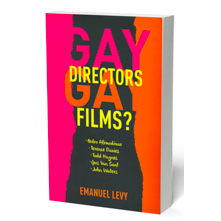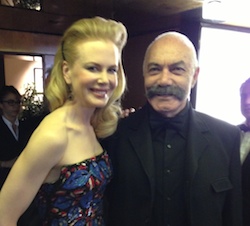Pandora’s Box
Title
The movie’s title refers to Pandora of Greek mythology, who upon opening a box given to her by the Olympian gods released all evils into the world, leaving only hope behind. In the film, this connection is made explicitly by the prosecutor in the trial scene.
The film is notable for its lesbian subplot–the attraction to Lulu of Countess Augusta Geschwitz, whose character is defined by masculine look; she wears a tuxedo.
My Book:
Pandora’s Box had previously been adapted for the screen by Arzén von Cserépy in 1921 in Germany under the same title, with Asta Nielsen as Lulu. The existence of a musical, plays and other adaptations– the familiarity of the Pandora’s Box story allowed writer-director G. W. Pabst to take liberties with the text.
Pabst searched for months for an actress to play the lead of Lulu. After seeing American actress Louise Brooks as circus performer in the 1928 Hawks’ film A Girl in Every Port, Pabst tried loan her from Paramount. His offer was not known to Brooks, who left the studio over salary dispute. Pabst’s second choice was Marlene Dietrich. Years later, Brooks said that Pabst was reluctant to hire Dietrich, as he felt she was too old at 27, and not a good fit for the character. Pabst himself wrote that Dietrich was too knowing, while Brooks had both innocence ability to project sexuality, without calculated coyness.
The film was made in Berlin at the Nero-Film Studio between October 17 and November 23, 1928.
“I revered Pabst for his truthful picture of this world of pleasure, which let me play Lulu naturally. The rest of the cast were tempted to rebellion.” Brooks on the filming experience, 1965.
Pabst drew on Brooks’ background as dancer with the pioneering modern ensemble Denishawn, “choreographing” the movement in each scene and limiting her to single emotion per shot.
Pabst hired tango musicians to inspire Brooks between takes, coached a reluctant Alice Roberts through the lesbian sequences, and appeased Fritz Kortner, who disliked Brooks.
During the first weeks oof filming, Brooks partied every night with her current lover, George Preston Marshall, much to Pabst’s displeasure. When Marshall left, a relieved Pabst imposed a stricter lifestyle on his star.
Fritz Kortner refusing to speak to Brooks on the set. Brooks later recalled: “Kortner, like everybody else on the production, thought I had cast some blinding spell over Pabst that allowed me to walk through my part… Kortner hated me. After each scene with me, he would pound off the set to his dressing room.”
Brooks felt that Pabst used the actors’ personal animosities to the benefit of the film’s dynamics, urging them to sublimate their frustrations.
The film premiered February 9, 1929 at the Gloria–Palast in Berlin. It was released in Germany as a nine reel (10,676 feet) production with running time of about 131 minutes.
Upon release in Germany, Pabst was accused of making “scandalous version” of Wedekind’s plays, in which the Lulu character is presented as “a man-eater devouring her sexual victims.” Critics in Berlin dismissed the film as a “travesty” of its source material.
The presentation of the Countess as lesbian was also controversial. Brooks was castigated as a “non-actress,” but the he ire that Brooks her performance got was seen by other as rooted in her being American.
Censorship and Movie’s Different Endings
The film underwent censorship in various countries. In France, itwas significantly re-edited from its original cut, making Alwa’s secretary and the countess Lulu’s childhood friends, eliminating the lesbian subplot. In the French cut, Lulu is found not guilty at her trial, and there is no Jack the Ripper; the story ends with Lulu joining the Salvation Army. This cut was also released in the U.K.
Truncated cuts of the film were also screened in the U.S., with various lengths, and concluding the same as the French and British editions, with Lulu escaping to join the Salvation Army.
In 1929, the film was banned in Finland, Norway, and Sweden. The film was also banned in The Netherlands in 1930, but it was shown in Amsterdam at the De Uitkijk theatre on October 18, 1935.
After the rise of the Nazi party, the film was banned in Germany between 1933 and 1945.
Critical Reaction Then
The film screened in New York December 1, 1929, also in truncated version. Critic Irene Thirer of the NY Daily News complained about the edits made to what “must have been ultra-sophisticated silent cinema in its original form.”
On December 8, 1929, The Film Daily also published a review, written by Jack Harrower, based on his viewing a heavily censored version, with a running time of only 66 minutes. Harrower noted that what he saw was a “hodgepodge” that offers “little entertainment” due to the film being “hacked to pieces by the censors.”
“Louise Brooks has the part of an exotic girl who attracts both men and women. She is a sort of unconscious siren who leads men to near-doom although her motives are apparently quite innocent…. A sweet ending has been tacked on to satisfy the censors, and with the rest of the cuts, it is a very incoherent film. It is too sophisticated for any but art theater audiences. G. W. Pabst’s direction is clever, but the deletions have killed that, too.”
Variety described Pandora’s Box as incoherent or “rambling” in its December 11 review, based on screening at Manhattan’s 55th Street Playhouse, which screened longer version, about 85 minutes. But he too discussed the ruinous effects of the extensive cuts: “Management at this theater blames the N.Y. censor with an ending in which Pandora and boy friends joining the Salvation Army.”
The NY Times reviewed the film in December 1929, at Manhattan’s 55th Street Playhouse, after which critic Mordant Hall wrote that it was “a disconnected melodramatic effusion, seldom interesting.” He notes that Brooks is “attractive” and “moves her head and eyes at the proper moment,” but found her facial expressions in portraying various emotions on screen “often difficult to decide.” Hall complimented he film’s cinematography, “the German production was filmed far better than the story deserves.”
Despite mixed reviews, the film drew viewers to its American debut. The New York Sun reported Pandora’s Box “ has smashed the Fifty-fifth Street Playhouse’s box office records. It will therefore be held for another week”.
After New York, Pandora’s Box was shown at the Little Theater in Baltimore (January 1930), Acme Theater in New York City (May 1930), Little theater in Newark, New Jersey (May 1931), and 5th Ave. Theater in New York City (December 1933).
The film’s last known public showing in the U.S. prior to its later revival was at the Sunday playhouse at Taliesin, the Wisconsin estate of Frank Lloyd Wright, in May, 1934.
Critical Status Now
Though it was largely dismissed by critics upon initial release, Pandora’s Box was rediscovered by film scholars in the 1950s and 1960s and began to accrue acclaim, eventually earning the reputation of being an unsung classic.
It is now considered one of the classics of Weimar Germany’s cinema, along with The Cabinet of Dr. Caligari, Metropolis, The Last Laugh, and The Blue Angel.
Brooks’ talent as an actress, which had been criticized upon the film’s release (mostly by German critics), was also subject to international reappraisal and acclaim from European critics and scholars, such as German scholar Lotte H. Eisner, and Henri Langlois, founder of French Cinematheque.
Restoration and New Soundtracks
A new 35mm print of Pandora’s Box was shown at N.Y. Film Forum in 2006 to great critical acclaim and commercial appeal for an indie or arthouse item.
In 2009, Hugh Hefner funded the film’s restoration, which was screened at the 2012 San Francisco Silent Film Fest with the note: “As a heavily censored film that deals with the psychological effects of sexual repression, Pandora’s Box meets two of Hefner’s charitable objectives: artistic expression and a pristine new film, both finally unfurled after decades of frustration.”
In 2023, the Hefner funded restoration was released on Blu-ray by the UK label Eureka.
Tarantino has listed Pandora’s Box as one of his 10 greatest films of all time.
Pandora’s Box was released on a two-disc DVD on November 28, 2006, by the Criterion Collection. Four soundtracks were commissioned for the DVD release to approximate the score audiences might have heard with live orchestra, Weimar Republic-era cabaret score, modern orchestral interpretation, and improvisational piano score.
Director’s Cut
The director’s cut, which appears on the 2006 Criterion Collection DVD, runs 133 minutes; this version was passed by the British Board of Film Classification (BBFC) as “uncut” in 2002.











